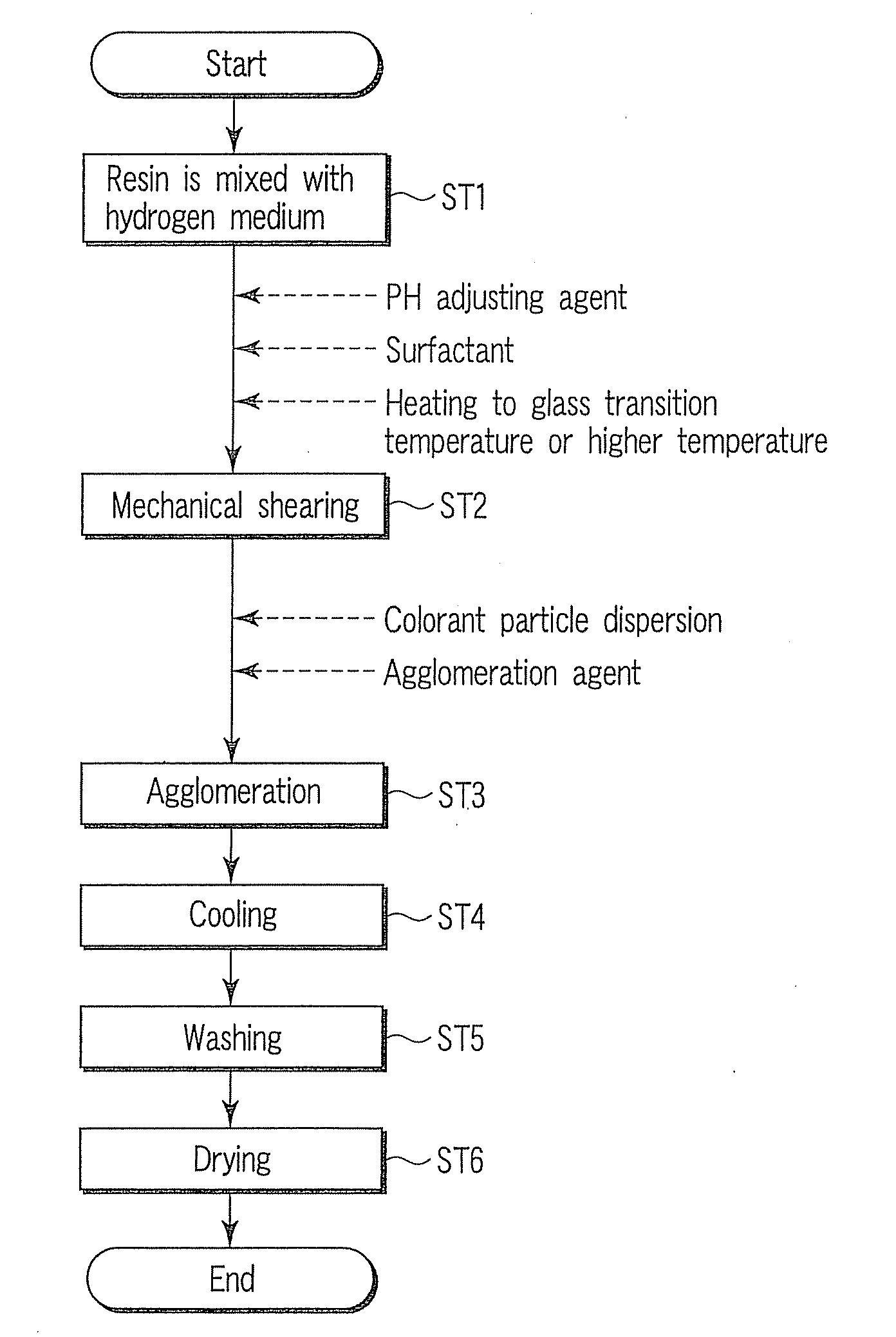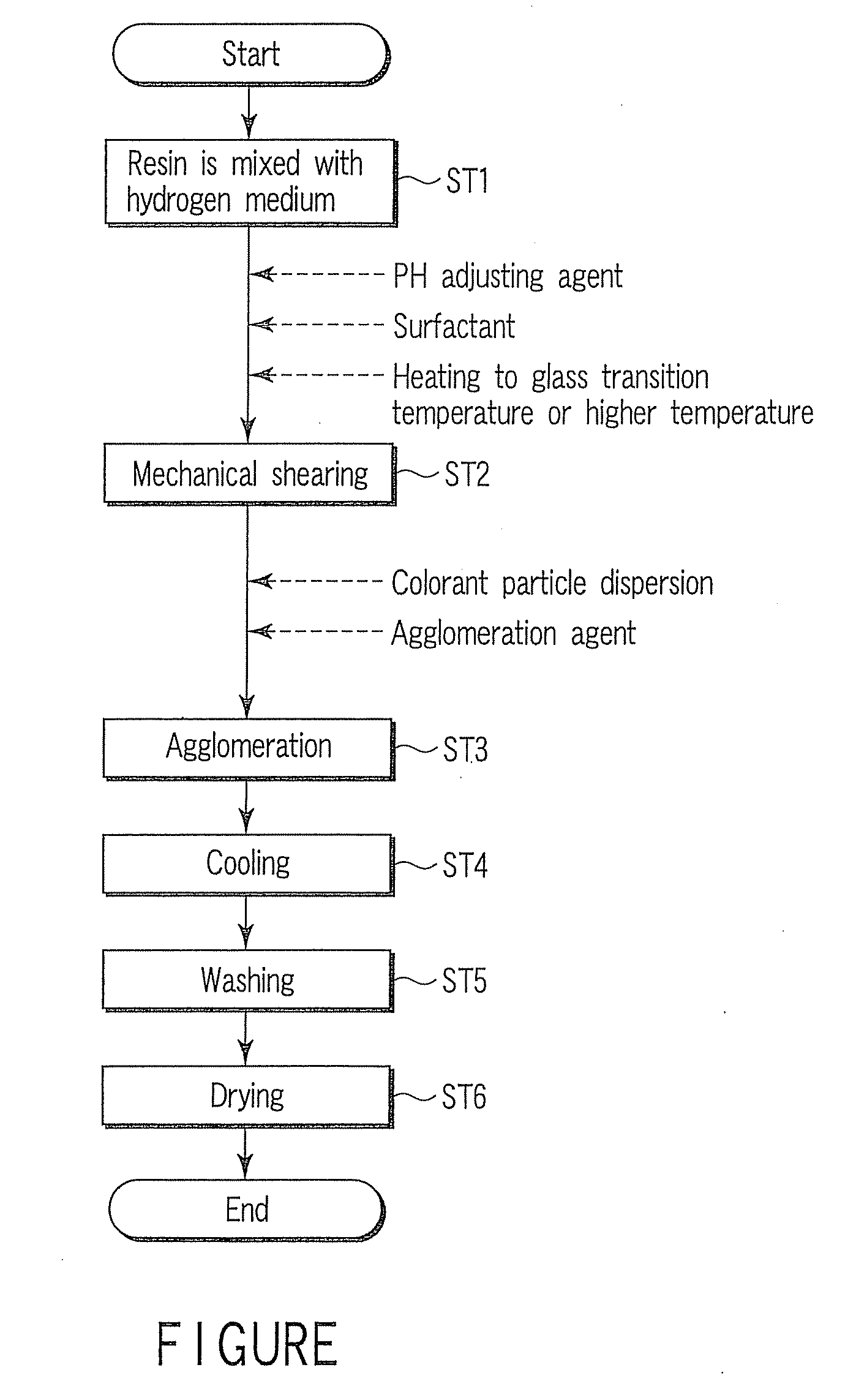Developing agent and method for manufacturing the same
a technology of developing agent and manufacturing method, applied in the direction of developers, optics, instruments, etc., can solve the problems of contaminating the developing roller, image support, carrier, and difficult to intentionally control the shape, and achieve the effect of small surface spread and good fixing ability
- Summary
- Abstract
- Description
- Claims
- Application Information
AI Technical Summary
Benefits of technology
Problems solved by technology
Method used
Image
Examples
embodiment 1
[0072]A total of 20 parts by weight of a polyester resin (manufactured by Kao Corp., glass transition temperature 62° C., acid value 20), 4 parts by weight of an anionic surfactant (Neoplex G-65, manufactured by Kao Corp.), 1 part by weight of an amine compound (triethylamine, manufactured by Wako Jun'yaku K.K.), and 75 parts by weight of ion-exchange water were charged into Cleamix (CLM-2.2S, manufactured by M Technique Co., Ltd.), and after the sample temperature has reached 80° C., the rotation speed of the Cleamix was set to 18,000 r.p.m, and stirring was conducted for 30 min.
[0073]Upon cooling, the volume-average particle size of the resin microparticles obtained was measured with SALD 7000 (manufactured by Shimazu Corp.). The result was 112 nm. A total of 5 parts by weight of the cyan pigment dispersion and 5 parts by weight of the wax dispersion were mixed with 90 parts by weight of the resin microparticle dispersion thus obtained, an aqueous solution of magnesium sulfate was...
embodiment 2
[0080]A total of 20 parts by weight of a polyester / styrene acryl hybrid resin (manufactured by Kao Corp., glass transition temperature 63° C., acid value 2), 4 parts by weight of an anionic surfactant (Neoplex G-65, manufactured by Kao Corp.), 0.8 part by weight of an amine compound (triethylamine, manufactured by Wako Jun'yaku K.K.), and 75.2 parts by weight of ion-exchange water were charged into Cleamix (CLM-2.2S, manufactured by M Technique Co., Ltd.), and after the sample temperature has reached 80° C., the rotation speed of the Cleamix was set to 18,000 r.p.m, and stirring was conducted for 30 min.
[0081]Upon cooling, the volume-average particle size of the resin microparticles obtained was measured with SALD 7000 (manufactured by Shimazu Corp.). The result was 129 nm.
[0082]A total of 5 parts by weight of the cyan pigment dispersion and 5 parts by weight of the wax dispersion were mixed with 90 parts by weight of the resin microparticle dispersion thus obtained, the temperature...
embodiment 3
[0089]A total of 20 parts by weight of a polyester resin (manufactured by Kao Corp., glass transition temperature 60° C., acid value 5), 4 parts by weight of an anionic surfactant (Neoplex G-65, manufactured by Kao Corp.), 0.8 part by weight of an amine compound (triethylamine, manufactured by Wako Jun'yaku K.K.), and 75.0 parts by weight of ion-exchange water were charged into Cleamix (CLM-2.2S, manufactured by M Technique Co., Ltd.), and after the sample temperature has reached 80° C., the rotation speed of the Cleamix was set to 8,000 r.p.m, and stirring was conducted for 30 min.
[0090]Upon cooling, the volume-average particle size of the resin microparticles obtained was measured with SALD 7000 (manufactured by Shimazu Corp.). The result was 956 nm.
[0091]A total of 5 parts by weight of the cyan pigment dispersion and 5 parts by weight of the wax dispersion were mixed with 90 parts by weight of the resin microparticle dispersion thus obtained, 3 parts by weight of a cationic surfa...
PUM
| Property | Measurement | Unit |
|---|---|---|
| volume-average particle size | aaaaa | aaaaa |
| volume-average particle size | aaaaa | aaaaa |
| volume-average particle size | aaaaa | aaaaa |
Abstract
Description
Claims
Application Information
 Login to View More
Login to View More - R&D
- Intellectual Property
- Life Sciences
- Materials
- Tech Scout
- Unparalleled Data Quality
- Higher Quality Content
- 60% Fewer Hallucinations
Browse by: Latest US Patents, China's latest patents, Technical Efficacy Thesaurus, Application Domain, Technology Topic, Popular Technical Reports.
© 2025 PatSnap. All rights reserved.Legal|Privacy policy|Modern Slavery Act Transparency Statement|Sitemap|About US| Contact US: help@patsnap.com


